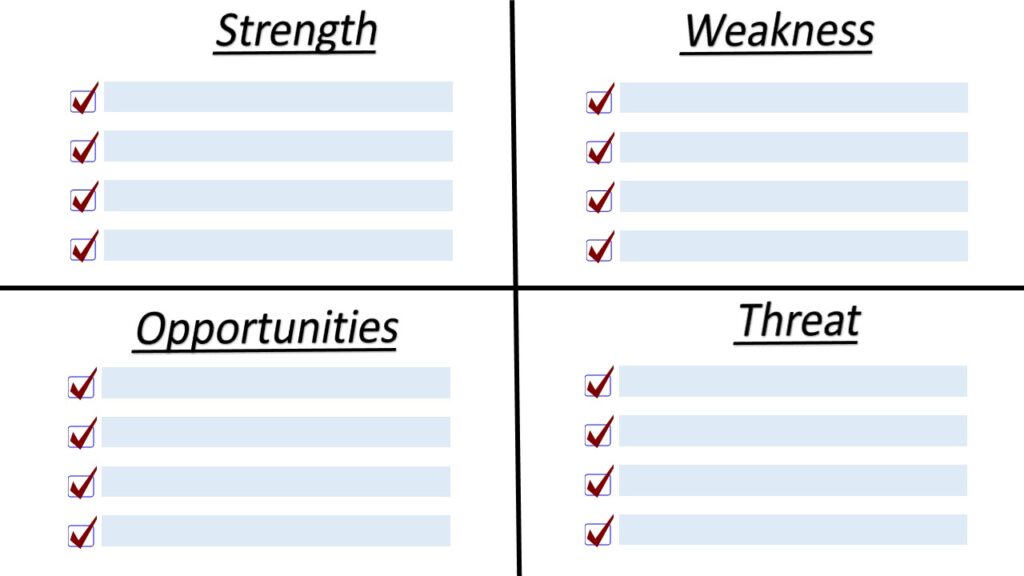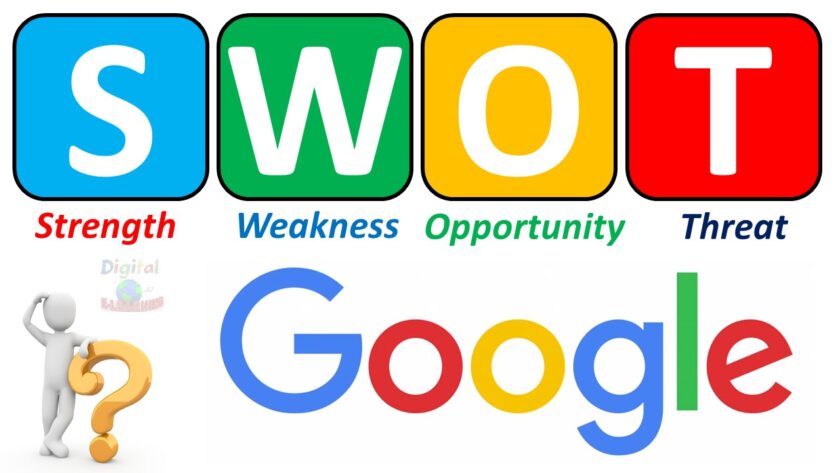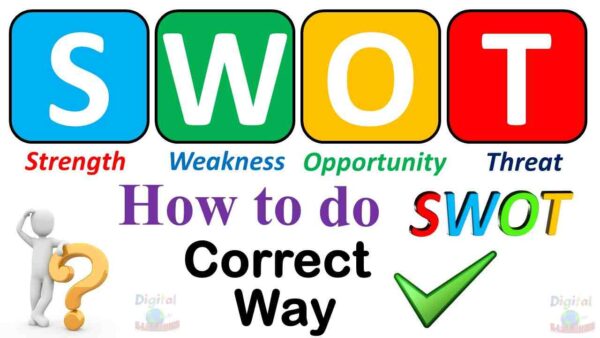In the dynamic landscape of business and decision-making, SWOT analysis has emerged as a valuable tool that helps individuals and organizations understand their internal strengths and weaknesses, as well as external opportunities and threats. By conducting a SWOT analysis correctly, one can gain valuable insights to formulate effective strategies. This comprehensive guide will take you through the process of conducting a SWOT analysis in the correct manner, highlight its essential components, and provide real-life examples to illustrate its practical applications. Furthermore, we will delve into the pros and cons of employing SWOT analysis as a decision-making framework.
What is SWOT Analysis ?
Well this SWOT analysis often comes up in the business discussion and also while developing strategies. Chances are you’ve at least heard of the term SWOT Analysis at-least one in life time. But what is a SWOT Analysis?
SWOT analysis is a simple but powerful tool that can be used by businesses of all sizes, in any industry. It is a strategic planning tool that helps you identify and analyze your organization’s strengths, weaknesses, opportunities, and threats.
SWOT analysis is often used to complete an objective assessment of a business, but the same analysis can actually be conducted on an industry, product, or even an individual.
SWOT analysis is another form of business evaluation where you can use it to evaluate your own business, some particular project, or even about yourself. The purpose of a SWOT analysis is to create a synthesized view of your company’s current state.
Its is a management tool which is used to evaluate company’s strategic plan and how to deal with internal and external factors.
McDonald’s SWOT analysis
Watch this YouTube video for detailed McDonald’s SWOT analysis.
SWOT FULL Form
SWOT is an acronym which simple stands for Strengths, Weaknesses, Opportunities, and Threats
- Strengths: These are the positive aspects of your organization that give you an advantage over your competitors.
- Weaknesses: These are the areas where your organization could improve.
- Opportunities: These are the external factors that could benefit your organization.
- Threats: These are the external factors that could harm your organization.
It’s important to understand that any business cannot exist in a vacuum. SWOTs allow you to think about your internal strengths and weaknesses, but also any external things that could affect your business’s performance.
And don’t forget that your competitors also have strengths and weaknesses and those are important to take into account when planning.
Meaning of SWOT/ Definition of SWOT
So SWOT analysis have been around since 1960s, although the origin of SWOT is not clear. But they are used by business across the world. SWOT analysis provides a fresh perspective on your business and what you are offering.
SWOT analysis is a tried-and-tested technique to represent where you currently are, and then take action to move ahead. You can make SWOT analysis part of your plans to start a new business venture. You can apply it to an existing business
We cannot create a perfect SWOT analysis without understanding what your customers are saying about what you’re doing well and what you’re not doing well.
SWOT is basically an overall evaluation of any company. So when we talk about Strengths and Weaknesses, these are internal to company where company has more control over it. On other hand if we talk about Opportunities and Threats they are external to the company where company has less control over it.
Internal Factors ( Strength & Weakness )
The first is the analysis of strengths and weaknesses Internal factors represents the internal characteristics, means that the company has some control over their development and implementation
Strengths :
Strengths are the area’s in which you excel or do better than anyone else ? Now, to Strengths are the area’s in which you excel or do better than anyone else ? Now, to identify your strengths, first think of what as you have done better than others, what areas are there in which no one can match you or even compete with you so called significant advantage and that are often difficult to mimic. How are we unique and special ?
What advantages do we have that others don’t. What are we great at doing things, What’s makes us so unique and special . Strength are normally the company’s USP which makes them the market leader. Strengths are internal and the positive attributes which company has.
Common strengths can include: brand recognition, Cost advantage, Best in class Quality, brand loyalty, strong financial, skilled and committed workforce, intellectual property like patents and trade secrets. For example, Amazon became famous by originally selling books online at competitive prices. The strength that makes Amazon offer those discount prices was its ability to maintain a cost advantage over others.
Weakness :
Next define what are your weakness. What are the area where you struggle or have fallen shot of mark. Or where are we lacking behind. Essentially these are areas in which the business does not excel and can serve as liabilities in the future. Weaknesses are like negative factors which will detract from your official strengths or USP’s resulting in the more focus from company side.
From a business perspective, weaknesses make a company vulnerable to competitors, which is why if a weakness is identified it’s typically a good idea to attempt to lessen the significance of it.
Companies like Dell, Google, Microsoft, Ebay, have all found a way to leverage advances in technology in order to provide value for their consumers.
Weaknesses often include negative brand reputation, poor quality of product, inexperience workforce, poor quality management system , poor distribution of networks, and very complicated organizational structure.
External Factors ( Opportunities and Threat)
Opportunities :
Opportunities may relate to financial, industry, societal, environmental or political issues, according to Better Evaluation. Competitors, everybody has competitors. Understand what your top three competitors are doing gives us good opportunities to be ahead of them.
Opportunities are areas that your business could take advantage of . Where is the potential, where can we grow and expand, which trends could benefit us.Is there an unserved or underserved market you could grow into? Are you maximizing your media coverage? Could you change or develop a product to better serve a wider audience? Your product might be great now but is there anything that could happen in the next six months that could change?
What about in the next year? From a business perspective it’s always important to be scanning the environment for possible opportunities, as they can serve as a unique advantage for companies if leveraged
Threat
Threats are areas you should be wary of. And by threat we mean what are your competitors up to ? Threat is a challenge posed by an unfavorable trend or development that you have no control over. Now to deal with threats we need to create a contingency plan. Like opportunities, threats are based on changes in the business’s external environment. However threats can harm the company in some way if they are not addressed.
Truthfully, many threats were once likely opportunities that the business failed to either identify, or maybe they identified the threat but downplayed its significant. Your product might be great now but is there anything that could happen in the next six months that could change. You need to be prepared for this and stay ahead of the game.
Competitors, everybody has competitors. Understand what your top three competitors are doing. Super important to have a holistic view of your external perspective As you embark on new innovative thinking for your business, consider using a SWOT analysis to jump-start the planning process.
How to Conduct a SWOT Analysis Correctly ?
- Gather information. This information can come from a variety of sources, such as your company’s financial statements, customer surveys, and industry reports.
- Identify your strengths and weaknesses. Be as specific as possible when identifying your strengths and weaknesses. For example, instead of saying “we have a good reputation,” say “our products are consistently rated highly by customers.”
- Identify your opportunities and threats. Again, be as specific as possible when identifying your opportunities and threats. For example, instead of saying “there is a growing demand for our products,” say “the global market for our products is expected to grow by 5% per year over the next five years.”
- Prioritize your findings. Not all of your strengths, weaknesses, opportunities, and threats will be equally important. Once you have identified all of your factors, prioritize them in order of importance.
- Develop strategies. Once you have prioritized your findings, you can start to develop strategies to capitalize on your strengths, overcome your weaknesses, exploit your opportunities, and mitigate your threats.

SWOT is 2×2 matrix with each cell represent Strength, Weakness, Opportunities & Threat
A good time to conduct a SWOT analysis is when your businesses is going through an area of change. This could be a launch, a new product, or a repositioning The best way to conduct a SWOT is to gather all the relevant stakeholders from different departments, and then have quick brainstorm session. Then we will tell everyone to list down everything that comes in your mind from Strength, Weakness, Threat and Opportunities. Once we are done with brainstorm session.
Whilst a SWOT analysis is a good starting point for evaluation, the disadvantage of a SWOT is that it doesn’t leave you with any actionable outcomes so you should always take the information you gather within the SWOT process and develop that further.
Once this list is ready, present it to the team and then use it to develop your business strategy or strategic planning.
SWOT analysis pros and cons :
Pros:
- SWOT analysis is a simple and easy-to-use tool.
- SWOT analysis can help you identify your strengths, weaknesses, opportunities, and threats.
- SWOT analysis can help you develop strategies to improve your organization’s performance.
Cons:
- SWOT analysis can be subjective.
- SWOT analysis can be time-consuming.
- SWOT analysis does not provide a detailed analysis of your organization’s situation.
Typical Application of SWOT includes :
- Problem-solving
- Decision-making
- Change management
- Big-picture planning
- New initiative launching
Convert your SWOT analysis outcome in actionable outcome or strategies :
- Use your Strengths to minimize Threats
- Use your Strengths to take advantages of Opportunities
- Improve Weakness by taking advantages of Opportunities
- Eliminate Weakness to avoid Threats
Example of SWOT analysis
Let look at the SWOT analysis of Google . Before we start the SWOT analysis of Google, it is important to know some facts or history of Google.
Google was founded by Larry Page and Sergey Brin in 1998 with total annual revenue of $160.86 Billion (2019). Its headquarters are in Mountain View, USA. Currently it is headed by Sundar Pichai, who is the CEO of Google. It is number search engine in the world.
1. Google SWOT Analysis / SWOT analysis of Google

Strengths:
- Market Dominance: Google is the most widely used search engine globally, with a massive market share, making it the go-to platform for accessing information on the internet.
- Strong Advertising Platform: Google’s advertising platform, Google Ads (formerly AdWords), generates a significant portion of the company’s revenue, benefiting from its extensive user data and targeting capabilities.
- Diverse Product Portfolio: Apart from search, Google offers a wide array of products and services, including Gmail, YouTube, Google Maps, Google Drive, Android OS, and more, contributing to its brand recognition and diversified revenue streams.
- Innovation and R&D: Google invests heavily in research and development, continuously introducing new technologies, products, and services, and staying at the forefront of technological advancements.
- Global Reach and User Base: Google’s services are used by billions of people worldwide, giving it an extensive global user base.
Weaknesses:
- Overdependence on Ad Revenue: The majority of Google’s revenue comes from advertising, making the company vulnerable to fluctuations in the advertising market and potential ad-blocking technologies.
- Privacy Concerns: Google has faced scrutiny over its data collection practices, leading to concerns regarding user privacy and regulatory challenges.
- Monopoly Allegations: Google has faced allegations of anti-competitive practices in certain markets, leading to regulatory investigations and potential legal challenges.
Opportunities:
- Cloud Computing Growth: Google Cloud Platform (GCP) is witnessing significant growth as more businesses adopt cloud-based services, presenting opportunities for Google to compete with established cloud providers like Amazon Web Services and Microsoft Azure.
- Artificial Intelligence and Machine Learning: Google’s expertise in AI and machine learning offers opportunities for innovation across its products and services, as well as potential applications in various industries.
- Expansion of Internet Access: Google’s initiatives, such as Project Loon and Google Station, aim to expand internet access to underserved regions, tapping into new markets and user segments.
- Smart Home and IoT: The rise of smart home devices and the Internet of Things (IoT) presents opportunities for Google to expand its presence through products like Google Nest and Google Assistant.
Threats:
- Intense Competition: Google faces fierce competition from other tech giants, such as Microsoft, Amazon, Apple, and Facebook, across multiple areas, including search, cloud services, and advertising.
- Data Security and Privacy Regulations: Increasing concerns over data security and privacy could lead to stricter regulations that impact Google’s data-driven business model.
- Ad-Blocking and Ad-Fatigue: The rise of ad-blocking software and user ad-fatigue may reduce the effectiveness of Google’s advertising platform and impact its revenue stream.
- Changing Search Behavior: Evolving user search behavior and the rise of voice search may alter the dynamics of the search engine market.
Google’s SWOT analysis highlights its dominant market position, diverse product portfolio, and continuous innovation as significant strengths. However, the company must address privacy concerns, diversify revenue sources beyond advertising, and navigate intense competition and regulatory challenges. Leveraging opportunities in cloud computing, AI, IoT, and expanding internet access can further solidify Google’s position as a leading technology company while mitigating potential threats.
2. Microsoft SWOT Analysis / SWOT analysis of Microsoft

Strengths:
- Strong Brand Reputation: Microsoft is one of the most recognized and respected brands in the technology industry, known for its reliable and innovative products.
- Diverse Product Portfolio: Microsoft offers a wide range of products and services, including Windows OS, Office Suite, Azure cloud services, Xbox gaming consoles, Surface devices, and more, providing diversification and revenue streams.
- Dominance in Operating Systems: Windows OS is widely used across the globe, making Microsoft a dominant player in the operating system market.
- Extensive Developer Network: Microsoft has a vast network of developers and partners who contribute to the growth and success of its platforms and products.
- Strong Financial Position: The company has consistently reported strong financial performance, providing the resources for investments in research and development and strategic acquisitions.
Weaknesses:
- Market Saturation in Some Areas: Microsoft faces intense competition in certain markets, such as mobile operating systems, where it lags behind competitors like Android and iOS.
- Legacy Software Dependency: While Microsoft has been successful in transitioning to cloud-based services, it still relies on revenues from traditional software products, which may face declining demand over time.
- Complex Product Integration: Integration and compatibility issues between various Microsoft products can sometimes lead to user frustrations.
Opportunities:
- Cloud Services Growth: Microsoft’s Azure cloud platform presents significant growth opportunities as businesses increasingly adopt cloud-based solutions for their operations.
- AI and Machine Learning: The integration of artificial intelligence and machine learning into Microsoft’s products opens new avenues for innovation and improved customer experiences.
- Expansion in Emerging Markets: Microsoft can further penetrate emerging markets, where there is a growing demand for technology products and services.
- Gaming Industry Expansion: With the success of Xbox consoles and gaming services, Microsoft can continue to capitalize on the expanding gaming industry.
Threats:
- Intense Competition: Microsoft faces fierce competition from tech giants like Google, Apple, Amazon, and others across various product lines.
- Data Security Concerns: The increasing focus on data privacy and security poses challenges for Microsoft, especially with its cloud services handling vast amounts of sensitive data.
- Rapid Technological Changes: Technology evolves quickly, and Microsoft must keep up with trends and advancements to remain relevant and competitive.
- Legal and Regulatory Challenges: The company operates globally and faces various legal and regulatory issues that may impact its operations.
Microsoft’s SWOT analysis reveals a company with strong brand recognition, diverse product offerings, and a solid financial position. However, it must address challenges such as market saturation, intense competition, and technological advancements. By leveraging its strengths and capitalizing on opportunities in cloud services, AI, and emerging markets, Microsoft can maintain its position as a leading technology player while navigating potential threats and weaknesses.
3. Amazon SWOT Analysis / SWOT analysis of Amazon

Strengths:
- E-commerce Dominance: Amazon is a leader in the e-commerce industry, operating in multiple countries and offering a vast range of products, making it a one-stop destination for consumers.
- Strong Brand Recognition: Amazon’s brand is widely recognized and associated with reliability, convenience, and fast delivery, building customer trust and loyalty.
- Diverse Product and Service Offerings: In addition to its e-commerce platform, Amazon has expanded into various sectors, including cloud computing (Amazon Web Services – AWS), digital content (Kindle), smart devices (Amazon Echo), and entertainment (Amazon Prime Video).
- Customer-Centric Approach: Amazon’s focus on customer satisfaction, seamless user experience, and personalized recommendations contributes to its competitive advantage.
- Advanced Technology and Innovation: Amazon invests significantly in technology and innovation, driving advancements in logistics, robotics, artificial intelligence, and data analytics to enhance efficiency and customer experience.
Weaknesses:
- Reliance on Online Sales: While Amazon’s e-commerce dominance is a strength, it also poses a risk, as the company is heavily dependent on online sales, making it susceptible to disruptions and changes in consumer behavior.
- Low Profit Margins in Some Segments: Amazon operates on thin profit margins in certain sectors, relying on volume sales and long-term customer value.
- Counterfeit and Pirated Products: The vast marketplace exposes Amazon to counterfeit and pirated products, leading to challenges in maintaining product quality and brand integrity.
Opportunities:
- Cloud Computing Growth: Amazon Web Services (AWS) has become a leading cloud services provider, and the increasing adoption of cloud technology presents opportunities for further growth and market expansion.
- Global Expansion: Amazon can continue expanding its presence in emerging markets, tapping into new customer bases and diversifying revenue streams.
- Acquisitions and Partnerships: Strategic acquisitions and partnerships can help Amazon enter new markets, enhance its offerings, and consolidate its position in the industry.
- Subscription Services: The success of Amazon Prime has shown the potential for subscription-based services, encouraging the company to explore new offerings in entertainment, education, and other sectors.
Threats:
- Intense Competition: Amazon faces fierce competition from various e-commerce players, as well as from traditional brick-and-mortar retailers expanding into the online space.
- Regulatory Challenges: As a large and influential company, Amazon faces increased regulatory scrutiny concerning antitrust, data privacy, and labor practices, which could impact its operations and reputation.
- Supply Chain Disruptions: Reliance on complex supply chains and international logistics exposes Amazon to potential disruptions due to natural disasters, geopolitical tensions, or other unforeseen events.
- Cybersecurity Risks: The company must remain vigilant against cyber threats and data breaches, as any security compromise could lead to reputational damage and loss of customer trust.
Amazon’s SWOT analysis reveals a company with strong market dominance, diverse product offerings, and continuous innovation. However, it also faces challenges in terms of thin profit margins, competition, and regulatory pressures. By leveraging opportunities in cloud computing, global expansion, strategic partnerships, and subscription services, Amazon can continue its growth trajectory while addressing potential threats and weaknesses. Maintaining a customer-centric approach and investing in advanced technology will be crucial to sustain its position as a leading player in the e-commerce and technology industry.
Conclusion
In conclusion, SWOT analysis is a versatile and valuable tool that empowers individuals and organizations to make well-informed decisions. By understanding its correct implementation, essential components, and real-world examples, you can harness the power of SWOT analysis to stay ahead in an ever-changing business landscape. However, it is essential to recognize its limitations and complement it with other strategic tools for comprehensive decision-making.
I hope this blog helped in understanding the basic concept in a simplified manner, watch out for more such stuff in the future.
📢📢 𝑺𝒐𝒄𝒊𝒂𝒍 𝑴𝒆𝒅𝒊𝒂 𝑳𝒊𝒏𝒌:
Thanks!!!
For questions please leave them in the comment box below and I’ll do my best to get back to those in a timely fashion. And remember to subscribe to Digital eLearning YouTube channel to have our latest videos sent to you while you sleep.
✍️ 𝓓𝓲𝓼𝓬𝓵𝓪𝓲𝓶𝓮𝓻: Copyright Disclaimer under section 107 of the Copyright Act of 1976, allowance is made for “fair use” for purposes such as criticism, comment, news reporting, teaching, scholarship, education and research. Fair use is a use permitted by copyright statute that might otherwise be infringing. The information contained in this video is just for educational and informational purposes only and does not have any intention to mislead or violate Google and YouTube community guidelines or policy. I respect and follow all terms & conditions of Google & YouTube.





